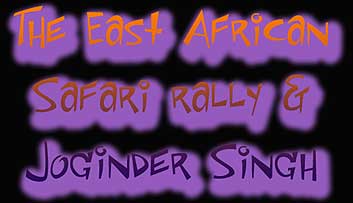
This article was written by Eric Cecil in 1973, which narrates the brief history of the East African Safari Rally. Although lots of action took place after 1973 - this introduction was deemed necessary . (Kanwal)
Introduction
Twenty-one
years after the first rally was run to mark the Coronation of Queen Elizabeth
II in 1953, the East African Safari Rally remains unique-an amalgam of gruelling
conditions and lOOkph average speeds through ideal, sparsely-populated country
unrivalled elsewhere in the world.
True, it now has its competitors. In Africa,
the Ethiopian Highland Rally and the Moroccan Rally duplicate some of the features
of the Safari; they may, indeed, siphon off a few of the would-be entrants from
the East African event. They can never match its unique character.
Motoring
News has called it "the most exacting test for man and machine yet devised
in the world of rallying." And world automobile manufacturers from Detroit
to Japan have been quick to note that success in the Safari is inevitably reflected
in a rise in the sales graphs of a market far wider than just East Africa.
How
did it all start ? Kenyans have long taken an interest in motor sport, and fifty
years ago the Royal East African Automobile Association had 1,000 members (83-2%
of all car owners in 1921). The Association-now the AA of East Africa and responsible
for the management of the Safari-had been founded in 1919 by L.D.Galton-Fenzi.
Galton-Fenzi
pioneered the Nairobi-Mombasa route driving a 1926 Riley. The trip took 15 days,
and from Voi to Mackinnon Road a track had to be hacked from the bush. He carried
out other surveys; Nairobi to Dodoma and on to what was Nyasaland and in 1931
across Africa to Lagos, through the Sahara to London.
In 1936, a road race
through the core of Africa from Nairobi to Johannesburg was staged, 2,715 miles
of route that had been largely pioneered by Galton-Fenzi. In a forward to the
route notes and maps for that race, he noted, "the marvellous strides made
in recent years as regards road construction and road maintenance." It was
a fortnight's drive from Cape Town to Nairobi.
The connection between those
early days and the present East African Safari Rally is tenuous, but real. In
1950 two Nairobi businessmen, Neil and Donald Vincent, had set a new record for
the Nairobi -Cape Town-Nairobi run. Later approached by their cousin Eric Cecil,
at that time chairman of the competitions committee of the REAAA, to race at Langa
Langa they were unenthusiastic.
The Langa Langa (present-day Gilgil) track
utilised the perimeter roads of a World War II military camp, providing a testing
3-3 mile circuit. Cecil was preoccupied with boosting interest in the track, but
the Vincents were non-committal. Instead, it is recorded, they made the alternative
suggestion that a long-distance drive such as they had undertaken the previous
year presented a greater challenge than going round and round a track.
So the
idea of the Safari was born. Cecil recalls that he thought initially in terms
of a road race around Lake Victoria, a proposition shelved when it was realised
that seasonal flooding in parts of northern Tanzania rendered this impracticable.
Eventually
various schemes and suggestions jelled. The Safari, to be run over roads in the
three East African states of Kenya, Uganda and Tanzania, became a reality in 1953.
It was staged over the holidays that marked the Coronation of Queen Elizabeth
II.
Regulations were as brief and simple as possible. There were only eight
controls-compared to the 57 control points in the 18th Safari of 1970-and there
was no provision for rest en route. Classification of the strictly standard production
saloon cars was by showroom price rather than engine capacity.

In the stirrups - Martin & McIntyre jockey their Morris Mini Cooper S through a muddy patch near Dar-es-Salaam in the 1966 Safari
Right
from the start, the organisers had their paid members in mind and were out to
prove just what value the new car buyer was getting for his money. Not even strengthening
of the vital suspension that inevitably took a tremendous pounding on the East
African roads of two decades ago was allowed.
The changes in the intervening
years have been considerable. The team of four Ford Escort RS 1600s which won
the manufacturers' team award in the 1972 Safari were fitted with heavy-duty suspension,
long-range fuel tanks, full underbody protection against pos-sible severe damage
by rocks and competition brakes.
Each car was fitted with "roo bars"
in the event of possible collision with wild animals and the now compulsory roll
bars. The Ford service manager put the preparation cost of each car at £8,000
and a fleet of service vehicles and co-ordinating service plane may have added
£20,000 to the bill.

Twice overall winner, in 1963 & 1968, 'Nick' Nowicki being congratulated the 'Sikh' way on his win.
But the 1953 method of classification by
showroom price was retained right up until 1959, with the internationally recognised
categorisation by engine capacity being introduced the following year. A price/performance
index was calculated from 1961, although in recent years this lost much of its
credibility and has since lapsed.
That inaugural year, and in fact for several
years thereafter, no advertising was allowed on the cars as compared with the
present day regulations which emphatically state: "Advertising on competing
cars is specifically encouraged." A colourful form of sponsorship made necessary
to offset the increased cost of the Safari over the years.
Of the eventual
57 starters in that first Coronation Safari-the nomenclature was changed in 1960
to East African Safari and five years later to the present title of East African
Safari Rally-some 28 were trade entries, although probably a considerable percentage
of the so-called "private" entries also had trade backing. The entry
fee was only Sh. 100 per car, which has since escalated to Sh. 1,500 for normal
entries and double that for late inclusions.
Three separate starting points
eventually proved necessary for the first Safari, plans to rail Tanzanian entrants'
cars to Kampala for a single mass start having proved abortive. This "Monte
Carlo" type start to the rally was retained for the next year's event, but
thereafter Nairobi was the start-finish point until 1970.
From 1963, the Governments
of the other independent East African states were reluctant to allow Kenya to
cream-off the considerable benefits that accrued from starting the Safari each
year, and Tanzania in particular made persistent efforts to induce the organisers
to start the rally from Dar es Salaam.
In 1969, matters came to a head, and
the Tanzania Government ruled that the rally would not be allowed to enter Tanzanian
territory. A route taking in only Kenya and Uganda was devised, with Nairobi the
starting point. Next year the Safari start and finish was moved to Kampala.
Meanwhile,
a reconciliation between the organisers and the Tanzanian Government had been
brought about, and although the Safari reverted in 1971 to the traditional Nairobi
start, the following year it was the turn of Dar es Salaam.
It now appears
likely that the starting point of the rally will rotate between the three East
African capitals, although for 1973-the year of the Safari's majority-Nairobi
has again been selected as the start-finish venue. For organisational reasons,
the route does not include Uganda.
42 of the 57 starters in 1953 opted to set
off from Nairobi, with eight chosing Kampala and seven Morogoro. Unlike current
Safari starts, from a ramp at two minute intervals, there was a mass start from
each of the three centres. Conditions throughout were atrociously wet and muddy.
"Typical" Safari weather!
Few competitors had the time or foresight
to carry out a reconnaissance of the route, a now essential feature with the modern
navigator of the genre of Henry Liddon, Chris Bates and Bev Smith compiling copious,
detailed notes of every aspect of the route.
But even in that first Safari
it was obvious that one crew was capitalising on a pre-rally recce and detailed
preparation of their Chevrolet-John Manussis and John Boyes. They motored confidently
to the finish for a Class D win.
Manussis, one of the Safari's great characters,
had to wait until 1961 to register the outright victory he sought for so many
years. Utterly nerveless, he is on record as once telling Lucille Cardwell when
she expressed a wish to get out of his car: "Lucy, if you
jump out now
you will surely be killed. If you stay with me you have a 50-50 chance!"
Incredibly,
Alan Dix-later to become Managing Director of Volkswagen Great Britain-and his
co-driver J.W. Larsen motored their Volkswagen into the Nairobi finish just 17
minutes behind schedule and first of 10 finishers to reach the capital. A further
17 crews to reach Voi 200 miles from Nairobi were also classed as finishers. Volkswagens
won the manufacturers' team prize.
Intrigued by the challenge of this novel
event, there were 50 starters the next year from Nairobi, Dar es Salaam and Kampala,
covering much the same route as in 1953. That had been a road race. The organisers
introduced a compulsory rest stop in 1954 and drastically reduced the required
average speed schedules to 36 mph for Class A and progressively one mile an hour
more for the next three classes.
Not suprisingly, 28 crews (of which three
were later disqualified) finished within the time allowed, half of this number
without incurring a single penalty point. The organisers devised an acceleration/
braking test as a tie breaker. Eventually this took place outside the Nairobi
City Hall following a heavy rain storm, having been moved from the Nairobi show-ground
(now Jamhuri Park).
Ironically, the Vincent brothers who put up the best performance
and two other crews were dis-qualified for exceeding the 30 mph speed limit in
the built-up area of Nairobi. Vie Preston and D.P. Marwaha (Volkswagen), third
in this thoroughly unsatisfactory test, were declared the winners.
Next year's
event was run under FIA rules and a RAC permit. Compulsory rest stops were increased
to four, the distance to 2,510 miles and the number of controls en route to 11.
Penalty points were imposed on final scrutineering of the vehicle at the finish,
as they still are for minor faults today.
Vie Preston and D.P. Marwaha won
the Safari outright, this time in a Ford Zephyr. Their second overall and third
class victory. They were first of 28 finishers from 58 starters, and once again
the ubiquitous Volkswagens won the manufacturers' team award for the third successive
year.
78 cars, the highest number of finishers in any Safari completed the
1956 rally, a dry, dusty affair with the 13 finishers who had "cleaned"
the route without a single penalty point undergoing a track test over one lap
of the Nakuru Park circuit to decide the issue.
This was the second
and last time that an extraneous test had to be used to adjudge the outcome of
the Safari. The Nakuru track test, to a predeter-mined formula, favoured the smaller
cars as did the tight circuit where the long-wheel based cars were handicapped
when cornering.
Eric Cecil and Tony Vickers' lap time in a DKW for 1 min 45-6
sec (the vastly more experienced race driver Jim Heather-Hayes in a Mercedes 220A
was 5-1 sec faster) gave them overall victory, and Simca won the manufacturers'
award, the first French marque to do so.
Run under a FIA permit, the 3,300
mile 1957 Safari was the first to achieve international status. But as in previous
years there was not a single overseas competitor and the rally was still very
much a parochial affair. "Gus" Hofmann and A.A.N. Burton took the premier
spot and spearheaded the Volkswagens to the manufacturers' team prize for the
fourth time. There were 19 finishers, with the rally being held for the first
time (and traditionally since) over the Easter Holiday.
A threatened boycott
by the motor trade before the start, a furore mid-way over the imposition of penalty
points when 45 cars were caught in two speed traps at Tanga and the decimation
of the survivors on the 92-mile stretch from Mbale to Suam River Bridge on the
second leg made this an unhappy Safari for organisers and competitors alike.
The
sealing of vital components had been introduced in 1957, and the next year's provisional
results were not confirmed until November following a protest to the RAC when
the seals on the front suspension of the class-leading Ford Anglia and Ford Zephyr
were found to be broken.
Initially penalised 2,000 and 1,000 points respectively,
this decision was rescinded following an appeal to the Stewards who concluded
that the seals had not been deliberately tampered with. Whereupon, the Mercedes
and Volkswagen entrants lodged a counter protest. A special tribunal re-imposed
the penalties, but the RAC arbitrators ruled the seals were inherently technically
weak and confirmed the Anglia and Zephyr in their class wins.
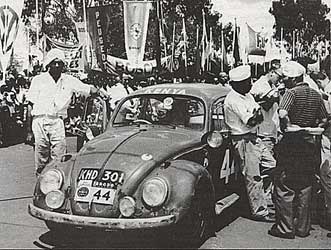
The charisma of the safari is captured in this 1962 photograph of the brothers jaswant & Joginder Singh Bhachu with their Cooper Motor Corporation entered Volkswagen. Joginder is being interviewed by Bikram Singh Bhamra of the Voice of Kenya.
Although
noteworthy for the inclusion of the first-ever overseas entries and the first
all-African crews, 1958 was indubitably a non-vintage year, for although there
were 54 finishers no overall winner was declared for the first and last time in
the history of the Safari: E. M. Temple-Boreham/M. P. Armstrong (Auto Union) won
the Leopard Class with 150 penalty points, an identical score with Lion Class
leaders A.R. and K.M. Kopperud (Zephyr) around whom the great seals protest had
raged. Volkswagen won the manufacturers' team award for the fifth time.
Overseas
interest continued for the 1959 event, won by Jack Ellis with his step-son Bill
Fritschy as co-driver in a Mercedes 219, first of three outright victories for
Mercedes. They repeated this feat the following year for the "double",
Fritschy failed to achieve a unique three-in-a-row in 1961 by just five minutes.
As
it is, no-one has yet won the Safari three times, although Vie Preston/D.P. Marwaha
(1954/55), "Nick" Nowicki/Paddy Cliff (1963*68), Bert Shank-land/Chris
Rothwell (1966/67) and Edgar Herrmann/ Hans Schuller (1970/71) are other crews
to have achieved the double.
Taking no chances on a repeat of the 1958 rumpus
over seals, the organisers in 1959 not only redrafted the regulations but supplemented
the seals with a special yellow, radio-active paint. A Geiger counter reading
taken on application was checked after the rally making the replacement of components
without detection virtually impossible.
Overseas interest in the 1959 rally
was considerable with (as detailed elsewhere) the British motoring Press strongly
represented in Tommy Wisdom, a member of the winning Ford team in 1961, Court-enay
Edwards and Peter Gamier of Autocar. Richard Bensted Smith, later editor of Motor,
drove the following year with Peter Hughes for a class win.
The Safari was
filmed for British television in 1960, and BBC, ITV and Visnews have provided
subsequent coverage. Upward of 100 overseas journalists now cover the event for
newspapers, motoring magazines, radio and television around the world.
The
Ellis/Fritschy combination triumphed again in 1960, one of the wettest Safaris
on record. Wide-spread flooding in Tanzania necessitated changes of route even
before the start. Ford won the manufact-urers' team award for the second successive
year, and included in the winning team were Coupe des Dames winners Lucille Cardwell
and Anne Hall in a Ford Zephyr.
The 1962 Safari ushered in the Pat Moss-Eric
Carlsson era; two of the record 33 overseas drivers competing in the tenth rally
of the series. East African fans took them enthusiastically to their hearts. Pat
Moss came within an ace of an outright win at her first attempt, but Kiambu coffee
farmer Tommy Fjastad and B. Schmider came through for yet another Volkswagen success.
In
1963, the Safari's reputation was further en-hanced when included for the first
time as a qualifying rally in the RAC manufacturers' world rally champion-ship.
It was a year notable, too, for the first Japanese factory entered cars-in the
years ahead to play such a decisive role in the rally.
Freak weather conditions
again tested the elasticity of the Safari organisation to the full, with only
seven of the 84 starters struggling back to the finish. Polish-born, long-time
Kenya resident "Nick" Nowicki and Paddy Cliff were the outright winners
in a Peugeot 404, and were to underscore their mastery of these muddy marathons
when they won the 1968 Safari, again first of seven finishers from a field of
91.
Second were Peter Hughes and Billy Young in a Ford Anglia, a disappointment
they erased from their memories the following year with outright victory in the
1964 rally driving a Ford Cortina GT. Team-wise, that year proved another Ford
benefit, with the Cortina's securing the manufacturers' award.
Brothers
Joginder and Jaswant Singh made Safari history in 1965 when they motored their
second-hand Volvo PV 544 into first place overall, and became the first all-Asian
crew to achieve an international rally success. They had a tremendous welcome
from a huge partisan crowd, having drawn first place and main-taining premier
spot virtually all the way to the finish.
The mass start of the first year
had given way in 1954 to the interval start, with the smaller cars the first away.
The starting order was reversed in 1958 and the next year, and in 1960 the organisers
ex-perimented with an unrestricted ballot for starting positions irrespective
of size or class.
This was varied from 1961 to 1963, when a ballot was held
for starting order in the individual classes with the smaller cars starting first.
The next year this was further changed by the addition of a ballot for starting
order between the classes.
The straight all-in ballot came back into
favour in1965 for two years, but then in 1967 the seeded start (into groups depending
on competition success in the preceding year, experience and competence) was introduced.
This has been retained up-to-date. A ballot is held for order of start within
the groups. The record of the "Flying Sikh" in the Safari is outstanding.
Born in Kericho, Joginder was in 1965 the East African rally champion, winning
outright the Uganda Rally and Tanzania 1000 as well as the Safari. Entered in
every Safari since 1959, he has failed to finish only once, in 1972.
Tanzanians
Bert Shankland and Chris Rothwell in 1966 were the first non-Kenya based crew
ever to win the Safari, taking first position overall in a Peugeot 404. This was
no flash-in-the-pan success, as they demonstrated the following year, giving this
French marque its third win in five years.
But Fords won the manufacturers'
team award both years, and Soderstrom and Palm in a Cortina Lotus made all the
running in the 1967 Safari, looking for the first 2,000 miles as if they would
achieve the history-making feat of being the first overseas crew to win. Luck
was against them.
President Kenyatta flagged away the first cars of the 1968
rally, with Nowicki and Cliff first of the "Unsinkable Seven" to make
it back to the Nairobi finish. As the cars headed north into the night, the rains
broke some six weeks earlier than usual and turned the route into one of the toughest
and most hazardous ever.
The weather had taken an early toll within 150 miles
of the start, with 18 cars enmired on the approaches to the Mau Escarpment in
atrocious conditions. Cars continued to drop out or were time-barred. Only seven
of the 21 cars which started on the southern leg survived. No manufacturers' team
finished.
Conversely, dust was the major hazard of the mile-a-minute 1969 rally.
Jock Aird, a Nakuru farming contractor, and Robin Hillyar won in a Ford 20M after
Soderstrom and Palm had again looked to be heading for that elusive overseas victory
until a broken differential put them out. Bunching was introduced, adding greatly
to the control and spectator appeal of the event.
But an acrimonious dispute
arose at the finish. It was found on scrutineering that the winning car differed
in material particulars (namely that the exhaust valves were three millimetres
larger) from details given in the homologation sheets.
Runners up Joginder
Singh and Bharat Bhardwaj protested to the Safari Stewards who, however, noted
that there was a satisfactory explanation and that a clerical error by Ford of
Cologne was responsible. An appeal to the RAG was contemplated as a challenge
to the validity of the Stewards' decision, but was not proceeded with.
It was
a frustrating Safari for Vic Preston and Bob Gerrish. Eliminated in 1968 by their
failure to obtain the relevant stamp at a control, they were within 600 miles
of the finish in the 1969 event when outright victory slipped from their grasp
yet again. Twice, in 1966 and 1967, this formidable duo had been second overall.
Atrocious
conditions characterised the 1970 rally, with speeds of more than 100 mph called
for on some sections. For the first time, the Safari started and finished outside
Kenya, at Kampala.
For Malindi hotelier Edgar Herrmann eight years of endeavour
were rewarded when he took first place overall driving a Datsun 1600SSS with Hans
Schuller after what the East African Standard called "an immaculate drive
which must rank as one of the greatest in Safari history."
However, the
rally was marred by the unfortunate death of a former Ugandan Army captain David
Ndahura who was driving with Ismail Sebbi. He was swept away and drowned when
his Peugeot 404 was marooned on the flooded Tiva Bridge near Kitui in the Kenya
section of the rally.
But fatalities in the Safari, despite the speed and ruggedness
of the country through which it is run, have proved gratifyingly few. The first
occured in 1957 when Somakraj and Charlie Safi failed to negotiate a corner leading
up to the Ruvu River bridge in Tanzania and plunged into the flooded river and
drowned.
In 1971, Nairobi University lecturer Cyrus Kamundia of Nyeri was killed
while on a pre-Safari recce with co-driver G. Gichuru in Tanzania, and the preceding
year a Japanese service crewman died in a crash before the Safari. The tragic
exceptions to an unusually fatality-free rally.
Safety belts were made compulsory
in 1962, and the roll bar in more recent years. Both have con-tributed to preventing
serious injury on many occasions, as has the strength of the modern all-steel
body. For "prangs" in the Safari have been numerous.
A record entry
of 118 cars made 1971 another milestone in the history of the Safari, which covered
an all-time high of 6,400 km. Overseas and African entries were also the highest
on record. Again it was Herrmann and Schuller, this time paired in the potent
Datsun 240Z, who gained outright victory.
Bjorn Waldegaard and Sobieslaw Zasada
were ahead of the field as the cars headed into Uganda, and with three-quarters
of the rally run, Waldegaard had a 23 minute lead and looked set to break the
jinx on overseas drivers.
But he crashed his Porsche trying to overtake his
team-mate Zasada, who was only 200 miles from the finish when his Porsche developed
intermittent engine trouble which the Stuttgart mechanics were unable to correct
and he gradually dropped back through the field for eventual fifth place overall.
So
near yet so far. . . the inevitable overseas victory which had eluded allcomers
for so long was eventually achieved in 1972. Hannu Mikkola and Gunnar Palm raced
their Ford Escort RS1600 into the Dar es Salaam finish for an historic overall
win and another manufacturers' team prize for the British marque.
For the first
time the Safari started and finished in the Tanzanian capital, the first cars
being nagged away by President Julius Nyerere. 18 of the 83 starters finished,
with Anne Taieth and Sylvia King Coupe des Dames winners in a Datsun 1600-the
first all-women crew to complete the Safari since 1968.
The Safari stands alone
as the sole international example of its kind, the most difficult rally in the
world. An almost parochial affair at the start, it has matured over two decades
into one of the great motoring events on the world calendar. Truly, the Safari
has come of age.

Some
impromptu cooling for this Zephyr at a checkpoint.
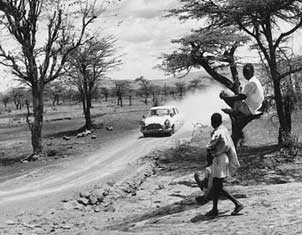
African spectators enjoying the Safari.

A Safari Zephyr throwing dust in a picturesque atmosphere.
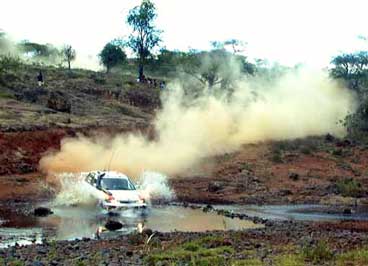
A Mitsubishi Lancer crossing a river.
THE FLYING SIKH - 'SIMBA YA KENYA'
JOGINDER SINGH
If anyone in East Africa achieved
the status of a national hero through motor rallying, it was undoubtedly Joginder
Singh. He was not only the first Asian driver ever to win an international rally
but also the first man to win the Safari three times. His tally of 19 finishes
in 22 Safari starts is unique: a record of consistency in 'the world's toughest
rally' that will probably never be beaten.
Sardar Joginder Singh Bhachu was
born on 9th February 1932 at Kericho in Kenyan in the western highlands. His father
Sardar Battan Singh came to Kenya in the 1920's from Village Kandola Kalan, near
NurMahal in the district of Jullundur, Punjab. His mother's name was Sardarni
Swaran Kaur. Joginder Singh was the eldest of eight sons and two sisters and was
educated at a boarding school at Nairobi. But engineering was already in his blood
as he was able to drive an old 1930s Chevrolet by the time he was 13.
He worked
as a spanner boy in his father's garage and later moved onto work with larger
motor companies and in 1958 became the first patrolman for the Royal East African
Automobile Association armed with a fearsome 650cc BSA motorcycle and sidecar.
Upto the age of 26 he had no experience of motor sport. His father was a fast
car driver, perhaps some of that had rubbed off on his son but it was probably
Joginder Singh's mechanical sympathy and meticulous car preparation that were
to have the biggest influence on his future rally career.
HIGHLIGHTS OF RALLEY
ACHIEVEMENTS OF S JOGINDER SINGH BHACHU East African Rally Champion:
1965 1970
& 1975 Kenyan Rally Champion:
1966 1967 1969 1970 & 1975
Motor Sportsman
of Year:
1970 & 1976
Won over 60 East African Championship
Rallies
in Kenya, Uganda and Tanzania.
Southern Cross Australia:
5th (1970) 4th
(1973) 2nd (1974)
overall in Mitubishi
Acropolis Rally Greece:
9th (1966)
overall in Volvo
We present some photos of bygone era of Joginder and his exploits
 The
SIMBA of Kenya being confronted by the SIMBA of the jungle
The
SIMBA of Kenya being confronted by the SIMBA of the jungle
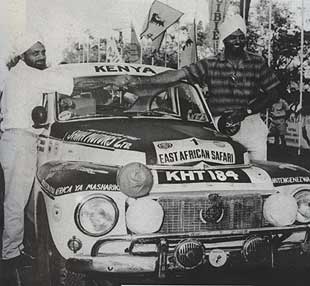
The
13th Safari certainly wasn't unlicky for the Sikh brothers Joginder & Jaswant.
They won the event in a second hand Vplvo PV544 that already had many thousands
of miles on the clock. The first ever international rally success by a non-European
crew. (The 13th safari had car no. 184 (total 13) PV544 (total 13) - Unlucky for
some BUT LUCKY for the Bhachu brothers)
Here is what one
paper wrote of the incredible victory:
VOLVO PV544
The
PV went from strength to strength, winning our own RAC rally, in probably the
fastest Volvo driver Tom Trana's hands in 1963 and 1964. It was a bit outdated,
as a rally car by then but in the correct hands was still a winner on rough, tough,
loose surface events. The best PV story of all I think is of Joginder and his
brother Jaswant Singh's 1965 East Coronation Safari win. Volvo had taken four
cars to Kenya in 1964 for tracks. It was accepted as the hardest event in the
calendar. The cars arrived too late that year and could not be tested under African
conditions and for a variety of reasons they all failed to finish. Volvo did not
take all the cars back to Sweden with them but left one for Joginder Singh to
rally in Africa for the rest of the year. During this time he modified the PV
and strengthened it where necessary and lowered the axle ratio. The car had covered
42,000 miles mostly under rally conditions. Joginder's intention was to enter
the 1965 Safari Rally. The story has a fairy tale ending, they won by 100 minutes.
You can perhaps imagine the headlines in the papers -
"Safari won in a second hand car." Joginder won again, but
not in a Volvo, in 1974 and 1976 just to show that the driver had a fair bit to
do with the result. Any of you lucky enough to attend a PV Register meeting a
few years ago at the Shuttle worth Trust in Bedfordshire would have been able
to see Joginder and his beloved PV (KHT 184) now immaculate in its original white
paint.
I just wonder if any of the old works cars are still in existence and
just what modifications the factory used in those no holds barred Group 6 events
like the Alpine and Liege. The 1961 Homologation papers show four wheel disc brakes
as well as the Joginder Singh inspired four damper front suspension set up. Did
they ever use two twin choke Weber or Solex carburetors as offered by the Volvo
R Sport in any events? It would not surprise me and I would love to know. I list
below the production records and model changes - these taken and other material
from Andrew Whyte s book the "Volvo 1800 and Family."
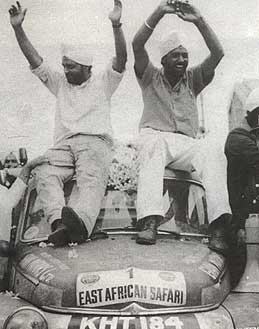
The
joy of winning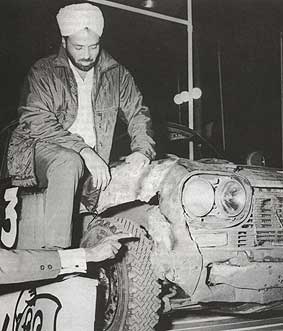
Joginder
& Smith were among the 'Unsinkable Seven' in 1968 and brought this Datsun
H130 back to the finish for fifth place overall.
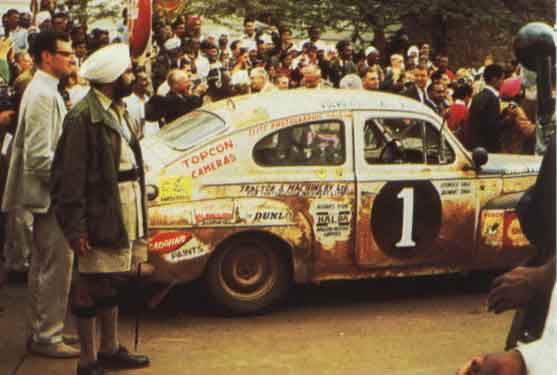 The
Volvo of Joginder being agmired by the enthusiatic crowd in Nairobi
The
Volvo of Joginder being agmired by the enthusiatic crowd in Nairobi
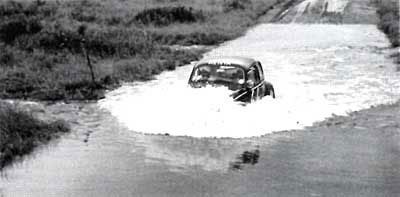
Joginder in a VW in 1960 safari driving through a river? or road?
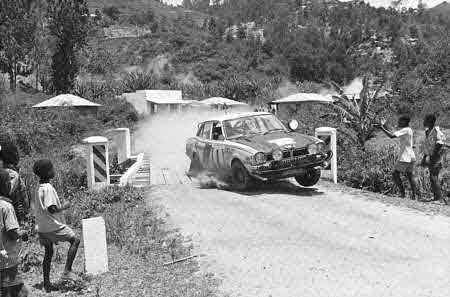
In a new Mitsubishi Colt Joginder jumps a bridge iand eventually won this event
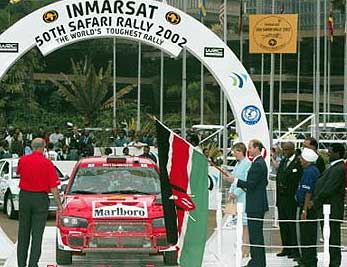
Prince Edward flagging off the 50th Safari Rally in Nairobi . Veteran driver Joginder Singh can be seen on extreme right.